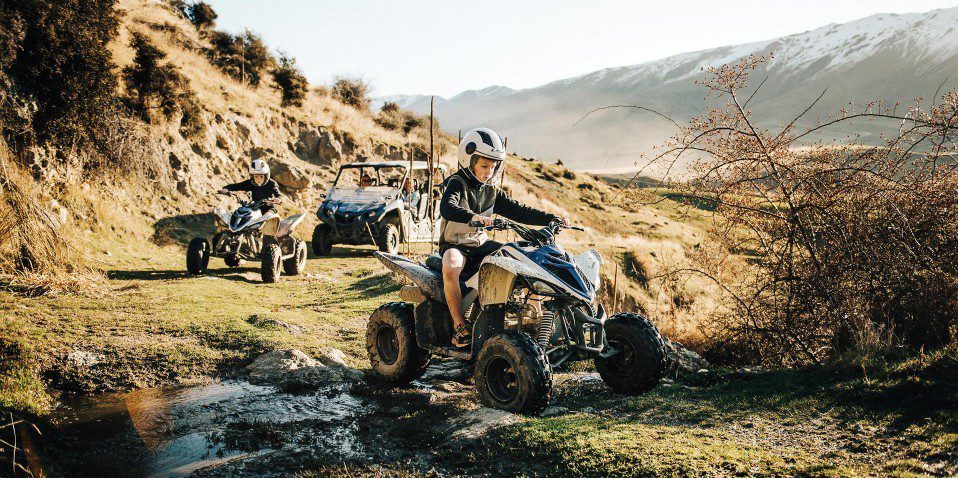Quad biking, also known as all-terrain vehicle (ATV) riding, is an electrifying sport that combines the thrill of motorcycling with the stability of four wheels. Riders traverse diverse terrains—from sandy dunes and muddy trails to rocky hillsides—experiencing the raw exhilaration of speed and the great outdoors. The unique design of quad bikes allows for maneuverability and adventure that few other vehicles can match, making it an appealing activity for thrill-seekers of all ages.
The Popularity of Quad Biking Among Youth
In recent years, quad biking has surged in popularity among younger individuals. The sport’s appeal lies in its ability to offer a sense of freedom and independence, allowing youths to break away from routine and immerse themselves in nature. The adrenaline rush, coupled with the opportunity to develop technical skills, makes quad biking an attractive pastime. Moreover, the rise of adventure parks and guided tours has made the sport more accessible, further fueling its allure among the youth demographic.
Safety First: The Importance of Age Regulations
While quad biking offers excitement, it also presents inherent risks, especially to inexperienced riders. Age regulations are crucial as they ensure that only individuals who have reached a certain level of physical and cognitive maturity operate these powerful machines. Establishing minimum age requirements helps prevent accidents caused by underdeveloped motor skills or poor judgment, thereby safeguarding young riders and those around them.
Global Overview of Minimum Age Requirements
Minimum age requirements for quad biking vary worldwide, reflecting differences in legal frameworks and cultural attitudes toward youth motorized activities. Some countries have stringent laws mandating higher age limits, while others adopt a more lenient approach, emphasizing parental discretion and supervision. This global disparity underscores the need for riders and guardians to be well-informed about local regulations.
Country-Specific Age Regulations
- United States: Age requirements differ by state. Generally, children as young as 6 may ride youth-sized ATVs under adult supervision, but operating full-sized quad bikes typically requires the rider to be at least 16.
- United Kingdom: Riders must be at least 16 to operate a quad bike on public roads with the appropriate license and insurance. Off-road, there’s no legal minimum age, but safety guidelines recommend no younger than 6 for child-specific models, always under adult supervision.
- Australia: Regulations are strict, with most states prohibiting children under 16 from operating quad bikes, especially on public land. Some exceptions exist for private property, but safety training and supervision are strongly advised.
Understanding these country-specific regulations is essential to ensure compliance and safety.
Factors Influencing Age Restrictions
Age restrictions are influenced by several factors:
- Physical Development: Younger children may lack the strength and coordination required to control a quad bike safely.
- Cognitive Ability: Operating an ATV demands quick decision-making and understanding of safety protocols, which develop with age.
- Legal Liability: Governments set age limits to reduce the risk of accidents and the associated legal and medical costs.
- Vehicle Classification: The power and size of the quad bike often dictate the minimum age for operation.
Engine Size and Power: Matching Bikes to Ages
Quad bikes vary significantly in engine capacity, typically measured in cubic centimeters (cc). Youth models range from 50cc to 125cc, designed for younger riders with limited speed and power. Matching the engine size to the rider’s age and experience is critical:
- 50cc to 70cc: Suitable for ages 6-11. These models are small, lightweight, and have speed limiters.
- 70cc to 90cc: Ideal for ages 12-15. They offer slightly more power but remain manageable.
- Over 90cc: Recommended for riders 16 and older, as they possess significantly more power and require greater control.
Supervision and Training: Key to Youth Riding
Adult supervision is paramount when youths engage in quad biking. Experienced adults can provide immediate assistance, enforce safety rules, and offer guidance on handling the vehicle. Additionally, formal training programs equip young riders with essential skills, teaching them how to respond to various riding conditions and emergencies.
Legal Implications of Underage Quad Biking
Allowing or encouraging underage individuals to operate quad bikes can lead to serious legal consequences. These may include:
- Fines and Penalties: Guardians may face financial penalties for non-compliance with age regulations.
- Criminal Charges: In cases of accidents causing injury or death, legal action could extend to criminal negligence charges.
- Civil Liability: Families may be held liable for damages resulting from accidents involving underage riders.
Understanding and adhering to legal requirements protects both the rider and the guardian from potential legal repercussions.
Insurance Considerations for Young Riders
Insurance policies for quad biking often have strict terms regarding the rider’s age. Key considerations include:
- Coverage Limitations: Policies may exclude coverage for accidents involving underage riders.
- Premium Costs: Insuring young riders can be more expensive due to the perceived higher risk.
- Validity: Operating outside legal age limits can render insurance policies null and void, leaving families financially vulnerable.
Securing appropriate insurance that acknowledges the rider’s age and complies with legal standards is essential.
Physical and Mental Readiness
Assessing a child’s readiness involves evaluating:
- Physical Strength: The ability to control the quad bike’s steering, brakes, and throttle.
- Coordination: Essential for maneuvering and responding to terrain changes.
- Mental Maturity: Understanding the importance of safety rules and the consequences of risky behavior.
- Attention Span: Maintaining focus during rides to monitor surroundings and potential hazards.
Parents should honestly appraise these factors before allowing their child to ride.
Risks Associated with Young Riders
Young riders face unique risks, including:
- Inexperience: Lack of riding experience can lead to poor decision-making.
- Peer Pressure: Desire to impress friends may encourage reckless behavior.
- Underdeveloped Judgment: Difficulty assessing danger accurately.
Mitigating these risks involves education, supervision, and setting clear boundaries.
Protective Gear: Essential Equipment for Safety
Proper protective gear significantly reduces injury severity in the event of an accident:
- Helmet: A certified, full-face helmet is crucial to protect against head injuries.
- Goggles: Eye protection from dust, debris, and branches.
- Gloves: Enhance grip and protect hands from abrasions.
- Long-Sleeved Clothing and Pants: Protect skin from scrapes and environmental elements.
- Boots: Sturdy, over-the-ankle boots prevent foot injuries.
- Body Armor: Chest protectors and elbow/knee pads offer additional safety.
Investing in quality gear is an investment in the rider’s well-being.
Training Programs for Young Enthusiasts
Numerous organizations offer training specifically for young riders:
- ATV Safety Institute (ASI): Provides hands-on courses teaching operational skills and safety practices.
- Local Clubs and Associations: Often host training sessions and riding events in controlled environments.
- Online Resources: Educational materials and videos that cover basic to advanced riding techniques.
Enrolling in these programs enhances competence and confidence.
Parental Responsibility and Consent
Parents and guardians play a critical role:
- Informed Consent: Understanding the risks and granting permission with full awareness.
- Setting Rules: Establishing clear guidelines about when, where, and how the child can ride.
- Ongoing Dialogue: Encouraging open communication about experiences and concerns.
Active involvement ensures that safety remains the top priority.
Choosing the Right Quad Bike for Your Child
When selecting a quad bike:
- Age Appropriateness: Choose models designed for the child’s age group.
- Safety Features: Look for speed limiters, remote shut-off systems, and automatic transmissions.
- Size and Weight: The bike should be manageable for the child’s stature.
- Brand Reputation: Opt for reputable manufacturers known for quality and safety.
Test rides and professional advice can assist in making the optimal choice.
Terrain Matters: Safe Environments for Youth Riding
Safe riding environments include:
- Designated Trails: Areas specifically maintained for ATV use.
- Private Property: Familiar grounds with known obstacles and boundaries.
- Closed Courses: Supervised settings with controlled conditions.
Avoiding public roads and hazardous terrains reduces the likelihood of accidents.
Alternatives for Younger Children
For children not yet of age:
- Electric ATVs: Lower speeds and easier handling suitable for very young riders.
- Pedal-Powered Vehicles: Develop motor skills without motorized power.
- Off-Road Bicycling: Introduces balance and coordination in a less risky environment.
These alternatives prepare children for future quad biking experiences.
Case Studies: Lessons from Quad Biking Accidents
Analyzing past incidents provides valuable insights:
- Incident Reports: Studies show that a significant number of ATV accidents involve underage riders without proper supervision.
- Common Factors: Lack of protective gear, inappropriate vehicle size, and risky behavior contribute to accidents.
- Preventative Measures: Emphasizing the importance of training and adherence to regulations can prevent future tragedies.
These lessons highlight the real-world consequences of neglecting safety.
Promoting Safe Quad Biking Culture
Communities can enhance safety by:
- Educational Campaigns: Raising awareness about age regulations and safety practices.
- Safety Workshops: Hosting events that teach proper riding techniques and equipment use.
- Legislation Advocacy: Supporting laws that enforce age limits and safety standards.
Collective efforts create a safer environment for all riders.
Conclusion: Balancing Adventure with Safety
Quad biking offers unparalleled excitement and the opportunity for personal growth. However, the fusion of adventure and safety is essential, especially when involving young riders. Adhering to minimum age requirements, investing in proper training and equipment, and fostering a culture of responsibility ensure that the sport remains enjoyable and secure. By balancing the innate desire for adventure with conscientious safety measures, we can provide enriching experiences that respect both the rider’s well-being and the community’s trust.





